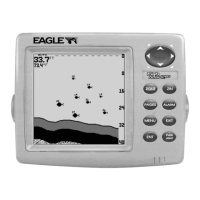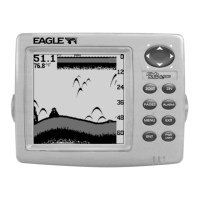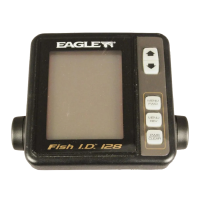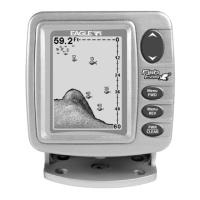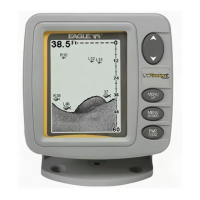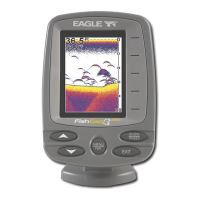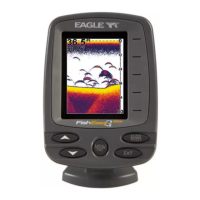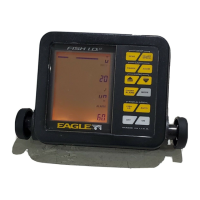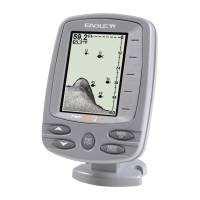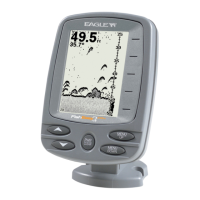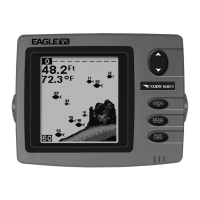Do you have a question about the Eagle FishMark 500C and is the answer not in the manual?
Details the technical specifications of the FishMark 500C and SeaFinder 500CDF sonar units.
Explains the fundamental principles of sonar technology and how it is used in fish finders.
Guides users on interpreting the text formatting and symbols used throughout the manual.
Outlines the initial steps and recommendations before starting the installation process.
Provides detailed instructions for installing the Skimmer transducer on different hull types.
Offers guidance on choosing the optimal location for the transducer for best performance.
Compares the advantages and disadvantages of shoot-thru-hull and transom mounting methods.
Explains how to properly connect the unit to a 12-volt power source.
Covers different methods for mounting the sonar unit, including gimbal, in-dash, and portable options.
Identifies and explains the function of each key on the sonar unit's keypad.
Describes how to access and navigate the unit's main menu for settings and functions.
A simplified, step-by-step guide for quick operation and common fish-finding scenarios.
Details basic functions and adjustments for operating the sonar unit effectively.
Explains the noise rejection system to improve display clarity under various conditions.
Covers the setup and function of the unit's different sonar alarm types.
Details the feature that identifies and displays fish symbols on the sonar screen.
Explains how to select between 50 kHz and 200 kHz transducer frequencies for optimal use.
Covers how to adjust sensitivity levels for optimal chart readability and target detection.
Describes how to use the zoom function to enlarge specific areas of the sonar display.
Provides steps to diagnose and resolve issues if the unit fails to power on.
Offers solutions for common problems like freezing, locking up, or erratic operation.
Addresses issues with bottom signal, erratic readings, or lack of fish detection.
Explains common causes of display noise and how to eliminate or minimize them.
Details the FCC rules and regulations that the device complies with.
Details the technical specifications of the FishMark 500C and SeaFinder 500CDF sonar units.
Explains the fundamental principles of sonar technology and how it is used in fish finders.
Guides users on interpreting the text formatting and symbols used throughout the manual.
Outlines the initial steps and recommendations before starting the installation process.
Provides detailed instructions for installing the Skimmer transducer on different hull types.
Offers guidance on choosing the optimal location for the transducer for best performance.
Compares the advantages and disadvantages of shoot-thru-hull and transom mounting methods.
Explains how to properly connect the unit to a 12-volt power source.
Covers different methods for mounting the sonar unit, including gimbal, in-dash, and portable options.
Identifies and explains the function of each key on the sonar unit's keypad.
Describes how to access and navigate the unit's main menu for settings and functions.
A simplified, step-by-step guide for quick operation and common fish-finding scenarios.
Details basic functions and adjustments for operating the sonar unit effectively.
Explains the noise rejection system to improve display clarity under various conditions.
Covers the setup and function of the unit's different sonar alarm types.
Details the feature that identifies and displays fish symbols on the sonar screen.
Explains how to select between 50 kHz and 200 kHz transducer frequencies for optimal use.
Covers how to adjust sensitivity levels for optimal chart readability and target detection.
Describes how to use the zoom function to enlarge specific areas of the sonar display.
Provides steps to diagnose and resolve issues if the unit fails to power on.
Offers solutions for common problems like freezing, locking up, or erratic operation.
Addresses issues with bottom signal, erratic readings, or lack of fish detection.
Explains common causes of display noise and how to eliminate or minimize them.
Details the FCC rules and regulations that the device complies with.

